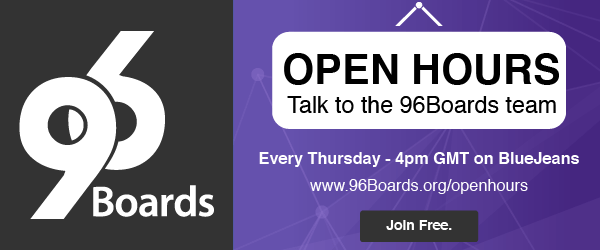Introduction
Ever wondered how to modify the device trees on 96Boards dynamically (i.e., without rebooting)? Isn’t it nice to have this cool feature on 96Boards to allow userspace modification to device tree in running kernel? This blogpost addresses all of the above mentioned issues!
Device tree in Linux kernel
Device tree is the most commonly used tool in Linux world for describing hardware. There are times when the entire hardware description was hard coded within the kernel itself. That actually worked well for x86 based systems but not for ARM based systems. In ARM even though the architecture is same between processors, they might be implementing their own set of peripherals. So, hard coding all of the board specific information caused lot of overhead and finally the developers switched to Device tree solution which was used by PowerPC.
In Layman terms, a device tree is a structure (dts/dtsi) which resembles tree for a platform. It has parent child relationship between its nodes. Because of its simplicity (not always :P) describing the hardware became easy and more importantly it can be built outside of the linux kernel using device tree compiler (dtc). So, the bootloader needs to load kernel image and device tree binary (dtbo) into SRAM and pass the dtbo address to kernel.
Then kernel can parse the device tree binary to identify the machine type and all of its peripherals etc… Device tree finds its usage for describing about the devices which couldn’t be hot plugged like USB, PCI etc…
The specification for device tree is maintained by Device tree Org in which Linaro is also one of the member.
Device tree Overlay
Having said the use of device tree, one question will pop up in our mind. Can we modify device tree without rebooting the systems? Yes we can :) That mechanism is called Device tree Overlays. This cool feature would allow us to describe the hardware present on add-on boards (Mezzanine in 96Boards) which could be stacked on top of the SBC any time.
But why do we need that? Can’t we specify the Mezzanine information on primary device tree itself? We can! But that makes no sense. Because, we are telling the kernel that so and so hardware has been attached to the system without actually having them.
So, the ideal scenario is to inform the kernel about hardware when the Mezzanine has been attached. This is the point where device tree overlay comes into picture. It allows specifying the device tree nodes for devices which is going to get attached into system. The resulting binary (dtbo) could be inserted into the kernel.
Inserting Overlays into Kernel
The support for device tree overlay was already merged into kernel. But there is no mechanism available in the mainline kernel to load device tree from userspace. Pantelis Antoniou, proposed a way of inserting device overlays using configfs dynamically. But due to some security concerns it was not manlined.
Eventhough, his work has been utilized by most of the popular SBC’s available in market, for instance Capemgr in BBB. We have followed the same approach and patched a custom kernel for this feature.
All of the instructions were documented in 96Boards/documentation git repository here. The changes were included in configs_overlay branch of my custom kernel tree. For making it compatible with the release branch, you need to merge those changes which is well documented in those instrucitons. For making the life easier for developers, example overlays were also provided. User can just modify them according to their needs.
As of now, instruction is only provided for DragonBoard410c, but extending this to all of our 96Boards is not a big deal though.
Conclusion
Well, I clearly mentioned that the above method is not our way forward, since this is not a mainline feature. There are some other ways to do it properly. One of which is loading the overlays via Uboot. Since, there has been a Uboot port already available for Dragonboard410c and overlay support is mainlined, it should be straightforward.
So, that’s the end of this blogpost about Device tree Overlays on 96Boards. Hope you found it useful and do let us know your valuable feedback in comments.







